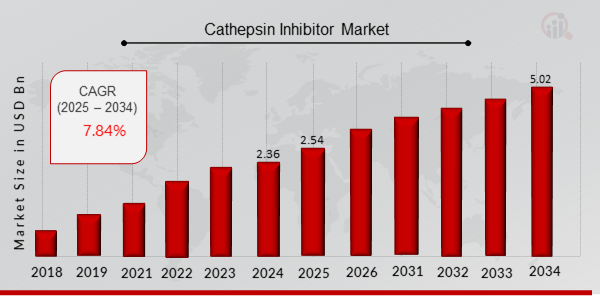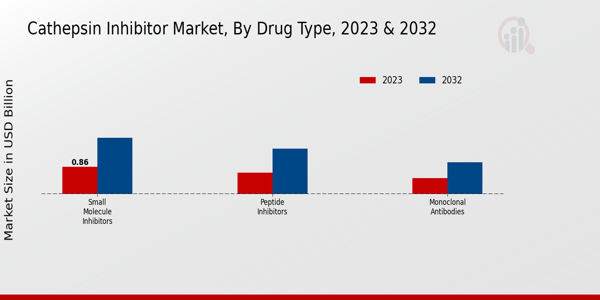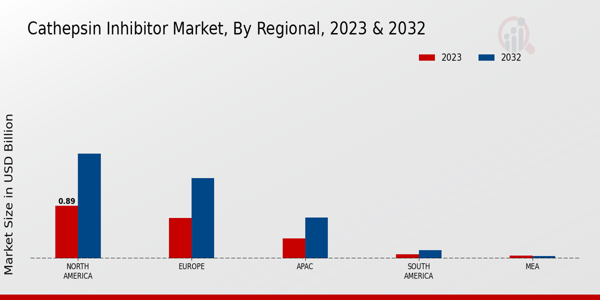Cathepsin Inhibitor Market Overview
As per MRFR analysis, the Cathepsin Inhibitor Market Size was estimated at 2.36 (USD Billion) in 2024. The Cathepsin Inhibitor Market Industry is expected to grow from 2.54 (USD Billion) in 2025 to 5.02 (USD Billion) till 2034, at a CAGR (growth rate) is expected to be around 7.84% during the forecast period (2025 - 2034).
Key Cathepsin Inhibitor Market Trends Highlighted
The Cathepsin Inhibitor Market is witnessing positive growth due to rising incidences and prevalence of diseases like cancer and other neurodegenerative disorders. The increasing demand for novel therapeutic interventions is compelling drug manufacturers as well as researchers to invest more in cathepsins targeting drug development. Furthermore, improvements in the drug delivery systems and an increasing emphasis on precision medicine are also stimulating the market. Increased appreciation on the therapeutic roles of cathepsin inhibitors is also providing a conducive atmosphere towards market growth as stakeholders understand that it is in the best interest of patients to have effective inhibitors developed.
There are significant opportunities to be explored within this market, particularly in regions where healthcare infrastructure is developing. Regulatory advancements and breakthrough designations can expedite the approval process for novel cathepsin inhibitors, allowing new entrants to join the market more easily. Additionally, collaborations between academia and industry are paving the way for innovative research, which can lead to the discovery of unique inhibitors. The competitive landscape also creates opportunities for partnerships and mergers, enabling companies to pool resources and expertise to bring new therapies to the market more effectively.In recent times, trends such as the rise in partnerships between biotechnology and pharmaceutical companies have become apparent. There has also been an increase in research focusing on cathepsin inhibitors in autoimmune diseases and metabolic disorders, highlighting their potential versatility beyond oncology. Moreover, the push towards biologics and monoclonal antibodies reflects a shift in therapeutic strategies, where cathepsin inhibitors are gaining traction as key players in the treatment landscape. The focus on precision medicine, coupled with ongoing research and development, suggests a promising future for cathepsin inhibitors in addressing complex health challenges.

Source: Primary Research, Secondary Research, MRFR Database and Analyst Review
Cathepsin Inhibitor Market Drivers
Rising Prevalence of Chronic Diseases
The Cathepsin Inhibitor Market Industry is significantly influenced by the increasing prevalence of chronic diseases such as cancer, cardiovascular disorders, and neurodegenerative diseases. As the global population ages, the incidence of these diseases escalates, necessitating the exploration of innovative treatment options. Cathepsin inhibitors have emerged as promising therapeutic agents due to their roles in extracellular matrix remodeling, inflammation, and cell death mechanisms that are pivotal in disease progression.Research indicates that an abnormal elevation of cathepsins is often associated with several chronic conditions, making them viable targets for intervention. The Cathepsin Inhibitor Market Industry is witnessing heightened interest from pharmaceutical companies looking to develop effective treatments for these conditions. Furthermore, increased funding and investment in biomedical research encourage the development of novel cathepsin inhibitors, thereby promoting their market growth.As more clinical trials yield positive results, we can anticipate a surge in product approvals, ultimately benefiting the Cathepsin Inhibitor Market Industry in the years to come.
Advancements in Drug Development
The ongoing advancements in drug development technologies are propelling the growth of the Cathepsin Inhibitor Market Industry. Innovative approaches in biotechnology and pharmacology have paved the way for the identification and synthesis of more effective cathepsin inhibitors. Techniques such as high-throughput screening and structure-based drug design are enhancing the ability to develop targeted therapies. As a result, the potential of cathepsin inhibitors to treat a wide variety of ailments is expanding, driving increased research activities and partnerships within the industry.This trend will likely lead to a greater number of product launches and improved therapeutic options for patients.
Growing Investment in Research and Development
Significant investment in research and development is fueling innovation in the Cathepsin Inhibitor Market Industry. Governments and private entities are recognizing the potential of cathepsin inhibitors and are allocating resources for their exploration and commercialization. This financial commitment supports not only academic research but also facilitates collaborations between research institutions and pharmaceutical companies. The focus on developing more effective and safer inhibitors is essential to meet the rising demand for novel treatment modalities, thereby stimulating market growth.Increased R&D activity is expected to yield more breakthroughs and fortify the positioning of the Cathepsin Inhibitor Market Industry.
Cathepsin Inhibitor Market Segment Insights:
Cathepsin Inhibitor Market Drug Type Insights
The Cathepsin Inhibitor Market within the Drug Type segment reflects a dynamic growth trajectory, with notable distinctions among its classifications, including Small Molecule Inhibitors, Peptide Inhibitors, and Monoclonal Antibodies. In 2023, Small Molecule Inhibitors accounted for a significant market share, valued at 0.86 USD Billion. By 2032, it's projected to strengthen its position, reaching 1.76 USD Billion. This growth highlights the increasing reliance on small molecules due to their ability to target specific pathways and their favorable pharmacokinetic properties, making them a pivotal choice in therapeutic protocols.In a closely related context, Peptide Inhibitors captured a value of 0.67 USD Billion in 2023, with expectations to elevate to 1.42 USD Billion by 2032. Their significance stems from their selectivity and potency against cathepsins, allowing for more targeted treatment options. Monoclonal Antibodies, while currently valued at 0.5 USD Billion in 2023, are expected to grow to 1.0 USD Billion by 2032, marking a steady expansion in their application. The unique mechanisms of action and the specificity of monoclonal antibodies position them as essential tools in managing diseases where cathepsin activity is evident.Overall, the Cathepsin Inhibitor Market segmentation reveals that Small Molecule Inhibitors dominate the landscape primarily due to their robust applicability and higher market holdings as compared to the other drug types, but Peptide Inhibitors and Monoclonal Antibodies are gaining momentum and are crucial for advancing therapeutic strategies against various conditions. The interplay and diversified efficacy of these categories underscore the potential for growth in the Cathepsin Inhibitor Market revenue, driven by research advancements and the demand for efficacious treatment modalities.

Source: Primary Research, Secondary Research, MRFR Database and Analyst Review
Cathepsin Inhibitor Market Therapeutic Area Insights
The Cathepsin Inhibitor Market is poised for substantial growth within the Therapeutic Area segment, showcasing its potential to reach a valuation of 2.03 billion USD in 2023. This market is driven by a growing understanding of the role of cathepsins in various diseases and the development of targeted therapies. Notably, cancer is a significant driver in this space, where cathepsin inhibitors have demonstrated effectiveness in tumor progression. Autoimmune diseases also significantly impact the market, as therapies targeting cathepsins can help in modulating immune responses.Neurological disorders represent another area of focus, with ongoing research pointing towards the role of cathepsins in neurodegenerative conditions, showing promise for future therapeutic interventions. Inflammatory diseases further contribute to the market dynamics, with cathepsin inhibitors offering potential benefits in managing chronic inflammation. Given the rising prevalence of these conditions and the accompanying demand for effective treatments, the Cathepsin Inhibitor Market segmentation reflects a robust landscape with substantial opportunities for growth in the upcoming years.
Cathepsin Inhibitor Market End User Insights
The Cathepsin Inhibitor Market is projected to be valued at 2.03 billion USD in 2023, with expectations of substantial growth in the coming years, reaching 4 billion USD by 2032. Within the End User segment, the market is primarily driven by Pharmaceutical Companies, Research Institutes, and Contract Research Organizations. Pharmaceutical Companies hold a significant share due to their role in drug development and the increasing demand for targeted therapies that utilize cathepsin inhibitors. Research Institutes are crucial for advancing scientific understanding and innovations in therapeutics, often leading to breakthroughs that can transform patient care.Contract Research Organizations facilitate the drug development process for pharmaceutical companies, providing essential services that enhance efficiency and productivity. The interplay between these end users is vital for sustaining market growth, as they collectively contribute towards the continuous advancements in cathepsin inhibitor applications, aligning with trends towards personalized medicine. The Cathepsin Inhibitor Market statistics reveal an upward trajectory aided by increasing investment in R and a growing focus on chronic diseases despite challenges such as regulatory hurdles and high costs associated with drug development.
Cathepsin Inhibitor Market Formulation Type Insights
The Cathepsin Inhibitor Market revenue is expected to reach 2.03 USD Billion in 2023, reflecting a growing interest in various formulation types. The market segmentation clearly indicates that the formulation type plays a crucial role in determining the efficacy and acceptance of cathepsin inhibitors. Within this context, the oral formulation type is particularly significant due to its convenience and ease of administration, making it a preferred choice among patients. Injectable formulations also have a strong presence as they often allow for more controlled dosing in clinical settings, thereby enhancing treatment effectiveness.Topical formulations, while representing a smaller segment, are essential for localized treatment options, especially in dermatological applications. The market growth is driven by an increasing prevalence of diseases requiring cathepsin inhibitors, alongside advancements in drug delivery technologies that improve formulation stability and patient compliance. However, challenges such as regulatory hurdles and the complexity of formulation development remain present. Ultimately, the Cathepsin Inhibitor Market statistics reflect a robust opportunity for innovation in formulation types, paving the way for enhanced therapeutic options.
Cathepsin Inhibitor Market Regional Insights
The Regional segment of the Cathepsin Inhibitor Market shows notable growth dynamics, with North America leading the valuation at 0.89 USD Billion in 2023 and projected to almost double by 2032, reflecting its major importance. Europe follows closely with a value of 0.68 USD Billion in 2023, indicating its significant role in the market, driven by advancements in pharmaceutical research. The APAC region, valued at 0.34 USD Billion in 2023, is emerging rapidly due to increasing investments in biopharmaceuticals. South America and MEA, while smaller at 0.07 USD Billion and 0.05 USD Billion, respectively, represent unique opportunities for growth given the rising healthcare demands and ongoing research initiatives.North America's majority holding emphasizes its established healthcare infrastructure and innovation capabilities, while Europe's growth is attributed to a strong regulatory framework promoting research. Overall, regional differences contribute to the diverse landscape of the Cathepsin Inhibitor Market revenue, revealing various strategic opportunities for stakeholders across different continents.

Source: Primary Research, Secondary Research, MRFR Database and Analyst Review
Cathepsin Inhibitor Market Key Players and Competitive Insights:
The Cathepsin Inhibitor Market has been gaining significant traction due to the increasing prevalence of various diseases linked to cathepsin enzymes, including cancer and neurodegenerative disorders. This has prompted pharmaceutical companies to invest in the research and development of cathepsin inhibitors, leading to a competitive landscape marked by innovation, strategic collaborations, and a focus on expanding therapeutic applications. The market is characterized by the presence of both established players and new entrants striving to establish a foothold by leveraging advanced technologies and novel drug formulations. The competitive dynamics also involve considerations such as pricing strategies, regulatory approvals, and the effectiveness of clinical outcomes, all of which can significantly impact market share and growth.Merck and Co. hold a prominent position in the Cathepsin Inhibitor Market due to its robust pipeline and commitment to developing targeted therapies that address critical unmet medical needs. The company’s strengths lie in its strong research capabilities, extensive experience in drug development, and established relationships with regulatory agencies. This gives Merck and Co. an edge in navigating the complexities of bringing cathepsin inhibitors to market. Its focus on precision medicine and personalized therapies aligns with current trends, enhancing its competitive advantage and market presence. Furthermore, Merck's ability to invest heavily in clinical trials and collaborations with academic institutions helps in advancing innovative solutions, thus positioning the company strongly within the landscape of cathepsin inhibitors.Pfizer also plays a vital role in the Cathepsin Inhibitor Market, marking itself as a notable contender through its focused research efforts and strategic initiatives aimed at expanding its therapeutic portfolio. The company's extensive experience in drug discovery and development allows it to implement a streamlined approach to creating effective cathepsin inhibitors. Pfizer is known for its commitment to innovation and has consistently invested in cutting-edge technologies that enhance its capability to deliver impactful treatments. Its global presence and established distribution channels facilitate a strong market reach, ensuring that its products achieve significant visibility and accessibility. Pfizer's collaborative efforts with other research entities and healthcare organizations further strengthen its ability to remain competitive in targeting the nuances of diseases related to cathepsin activity, reinforcing its significance in this evolving market.
Key Companies in the Cathepsin Inhibitor Market Include:
Cathepsin Inhibitor Market Industry Developments
Recent developments in the Cathepsin Inhibitor Market have seen a significant focus on innovative therapies aimed at treating various diseases, including cancer and autoimmune disorders. Companies such as Merck Co., Pfizer, Amgen, and Eli Lilly are actively advancing their research on cathepsin inhibitors, with multiple clinical trials showcasing promising results. Additionally, Roche and Sanofi have begun partnerships to explore synergies in their respective pipelines, potentially enhancing their competitive positions in the market. The valuation of companies in this sector has experienced a noteworthy increase due to the rising demand for targeted therapies, with AbbVie and Celgene reporting substantial growth in their revenue streams attributed to their novel cathepsin inhibitor candidates. Furthermore, MA activity has been prevalent, with Novartis acquiring smaller biotech firms specializing in cathepsin research to bolster its portfolio. Bristol-Myers Squibb and Johnson Johnson are also engaged in strategic initiatives aimed at expanding their reach, reflecting the growing interest in cathepsin inhibitors as a viable therapeutic option. As these dynamics unfold, the market landscape is evolving rapidly, driven by research advancements and corporate strategies.
Cathepsin Inhibitor Market Segmentation Insights
-
Cathepsin Inhibitor Market Drug Type Outlook
-
Cathepsin Inhibitor Market Therapeutic Area Outlook
-
Cancer
-
Autoimmune Diseases
-
Neurological Disorders
-
Inflammatory Diseases
-
Cathepsin Inhibitor Market End User Outlook
-
Cathepsin Inhibitor Market Formulation Type Outlook
-
Cathepsin Inhibitor Market Regional Outlook
-
North America
-
Europe
-
South America
-
Asia Pacific
-
Middle East and Africa
| Report Attribute/Metric |
Details |
|
Market Size 2024
|
2.36 (USD Billion)
|
|
Market Size 2025
|
2.54 (USD Billion)
|
|
Market Size 2034
|
5.02 (USD Billion)
|
|
Compound Annual Growth Rate (CAGR)
|
7.84 % (2025 - 2034)
|
|
Report Coverage
|
Revenue Forecast, Competitive Landscape, Growth Factors, and Trends
|
|
Base Year
|
2024
|
|
Market Forecast Period
|
2025 - 2034
|
|
Historical Data
|
2020 - 2024
|
| Market Forecast Units |
USD Billion |
| Key Companies Profiled |
Merck and Co, Pfizer, Amgen, Eli Lilly, Celgene, AbbVie, Teva Pharmaceutical Industries, Roche, Sanofi, GlaxoSmithKline, Boehringer Ingelheim, AstraZeneca, Novartis, BristolMyers Squibb, Johnson and Johnson |
| Segments Covered |
Drug Type, Therapeutic Area, End User, Formulation Type, Regional |
| Key Market Opportunities |
Rising cancer treatment demand, Increasing autoimmune disease prevalence, Expansion in pharmaceutical R investments, Growing public health awareness, Advances in personalized medicine approaches |
| Key Market Dynamics |
Rising prevalence of chronic diseases, Increasing investment in drug development, Growing demand for targeted therapies, Advancements in proteomics research, Expanding applications in oncology |
| Countries Covered |
North America, Europe, APAC, South America, MEA |
Frequently Asked Questions (FAQ) :
The Cathepsin Inhibitor Market is expected to be valued at 5.02 USD Billion by 2034.
The projected CAGR for the Cathepsin Inhibitor Market is 7.84% from 2025 to 2034.
North America is anticipated to have the largest market share, valued at 1.77 USD Billion by 2032.
By 2032, the market size for Small Molecule Inhibitors is expected to reach 1.76 USD Billion.
Key players include Merck and Co, Pfizer, Amgen, Eli Lilly, and AbbVie, among others.
The market for Peptide Inhibitors is estimated to be valued at 1.42 USD Billion in 2032.
The Monoclonal Antibodies segment is expected to reach a market value of 1.0 USD Billion by 2032.
In 2023, the market will be segmented into North America, Europe, APAC, South America, and MEA, with varying valuations.
The APAC market is projected to grow from 0.34 USD Billion in 2023 to 0.69 USD Billion by 2032.
Challenges include regulatory hurdles and competition among pharmaceutical brands that could affect market dynamics.

















